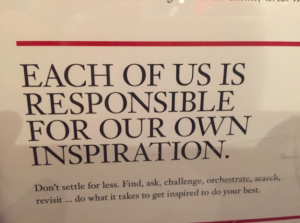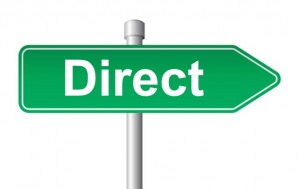By
Team DIGO | 12/09/2015 | in

I once worked in an agency that did good work, had smart people, and yet grew relatively slowly. Even though I was on the creative side of the business, I was an avid proponent of growth because I knew how much better and how much more fun a growing agency could be.
I did a little informal listening tour around the agency.Read More (more…)
By
Team DIGO | 12/02/2015 | in
Don’t settle for less. Find, ask, challenge, orchestrate, search, revisit…do what it takes to get inspired to do your best.

At DiMassimo Goldstein, we put our values in a document we call “The DIGO Standard.” It doesn’t just hang on the walls and sit on our desks and desktops. We use it every day. People who visit often ask for a copy. Here’s yours, and you didn’t even have to ask.
Join the INSPIRING ACTION tribe!
By
Team DIGO | 11/30/2015 | in
Key #7 of 10 to Inspiring Action: 10 Keys to the Future of Marketing. Download our summary poster of the 10 Keys here.
One of the best things about doing my Inspiring Action Interviews has been the opportunity to have deep conversations with several of my most successful clients.
These are the CMOs that CEOs worship – marketers who have been highly successful again and again.
A common theme came up as we talked about the formative experiences we’d shared.

“Since that time I’ve been what you’d call a Brand Direct marketer.” – Ty Shay, CMO LifeLock
“That methodology has become the methodology I’ve applied ever since.” – Leslie Dukker Doty, CMO the Reader’s Digest Association
I first wrote about “brand direct” publicly almost twenty years ago. Since then the direct economy has taken over our lives, and just about every industry has been disrupted by it. This has mostly been a very good thing for me, as our clients over the past two decades have been doing more than their share of the disrupting.
Drowning in data, today’s marketers cry out for coherence. Even with programmatic trading desks, dashboards and optimizations, incremental improvements are only detectible to sophisticated machines.
Significant, meaningful, ongoing improvements in marketing efficiency are still possible, however. They simply require more than mere visual and verbal consistency.

The answer begins with a journey of discovery. The path of that journey is the customer journey itself. Together, we learn to see things from the customer’s point of view, from the prospect’s perspective. We uncover the insight – the inspiring idea – that will change and organize everything.
Then, together, we mine that inspiring idea to accelerate growth by up to ten times. Of course, this also dramatically alters the marketer’s journey!
Let’s alter your journey too!
-Mark DiMassimo, Chief
By
Team DIGO | 11/19/2015 | in
Buying a mattress can be a disastrous struggle.
You trek to your local Sleepy’s. You bounce around from bed to bed, testing each out, all under the very ambitious belief that the 3-5 minutes you spend lying down will provide an accurate depiction of what a year’s worth of sleep will be like. Based off of that assumption, you proceed to spend roughly $1,000 on a mattress that you will inevitably have to haul up three flights of stairs, and somehow, some way, manage to fit through your tiny apartment door.

“Maneuver to the left!”
That doesn’t work.
“Tilt it to the right!”
Nope, that doesn’t work either. Eventually, with sore arms and an aching back, you get your overpriced mattress settled in its new home in your bedroom. But your precious Saturday afternoon? That has come and gone.
Enter Casper. An online, direct-economy mattress company that’s waking up a multi-billion-dollar industry.
Adopting the online retail model made famous by eyewear company Warby Parker, Casper is bypassing the middleman and delivering mattresses straight to your bedroom. The mattress, designed with cutting-edge technology, can be folded to fit inside of a box, providing Casper with a delivery capability unrivaled by competitors. Why is that significant? Well, by eliminating the 3rd-party supply cost, Casper can sell their mattress for a much cheaper price, increasing its value and putting smiles on customers’ faces.

For Casper, it was simple. Find out what your consumers are struggling with and provide a solution. By tackling the customer experience issue that has forever been associated with mattress shopping, Casper isolated itself from industry competitors who are still using outdated tactics. Casper put the customer first, and the customers have responded.
With a $55M investment this past June, Casper solidified itself as a pioneer of the direct-model revolution.
Retail giants like Sleepy’s cannot afford to sleep on Casper any longer.
For more on Casper, read our Inspiring Action Case Study HERE.
from: Shontell, Alyson. “There’s A ‘Warby Parker Of Mattresses’ That’s Shipping Fluffy, King-Size Beds In Boxes As Small As Golf Bags.” Business Insider. Business Insider, Inc, 22 Apr. 2014. Web. 20 Nov. 2015.
By
Team DIGO | 11/18/2015 | in
Sometimes we say, “actions, not ads,” but what if you find yourself working on an ad? What do you do?
Do you feel inspired to see your assignment as an action, not just an ad? Or do you feel like your company doesn’t value what you’re doing?
Does the challenge to make the ad not just creative, on brand, on strategy and effective, but also an action, feel inspiring? Or does it feel like we are freighting a banner or print ad brief with a standard that can only ever apply to a minority of what we do?
I think that sometimes inspiring action means inspiring actions. But sometimes it means ads that inspire action rather than just manipulate or motivate it.
For any given brand, we are likely to do both.
Instead of brand ads and direct ads, we’re doing inspiring actions and we’re inspiring action. Too often, brand ads just tell people what the brand claims to be about. And direct ads just try to bribe or manipulate people into responding.
The same brand could say one thing in its brand ads and act like a completely different company in its direct ads.
We say everything represents the brand. Even a selling email is an action that the company is taking. So, we don’t say, “No emails.” But we do say no brand-killing, manipulative soul-sucking emails.
We are not against ads. We’re against just ads. We’re against the idea that an ad is ever just a means of transmitting the information on the page or screen. Because the very fact of the ad as an action the company is taking speaks volumes about the company.
Are we saying that people think this deeply about ads.?Of course not. But it’s exactly because they react rather than consider, instinctively rather than rationally, that they judge this way.
When we say, “Actions, Not Ads,” we’re acting in a provocative way, hoping to provoke you to higher standards whenever you inspire, write, inform or work off of a brief.
Now, back to work.
By
Team DIGO | 11/03/2015 | in
Mark Taylor is a keynote speaker, leadership trainer and organizational consultant who uses his 35 years of experience as an accomplished CEO to run think tanks in Manhattan. Under his mentorship, hundreds of different organizations and executives have flourished.
In this episode of the “Inspiring Action Podcast”, Taylor talks about how his past experiences in the corporate world led him to an epiphany that ultimately transformed his outlook on growth and success. Shifting his focus towards the importance of a strong working environment and culture, Taylor’s career took an enlightened turn that will leave you feeling inspired
By
Team DIGO | 10/28/2015 | in
Recently there has been an influx of ad-block applications appearing on the App Store. These apps were developed in response to consumer backlash about the amount of advertising people were receiving when browsing on their smart phones, and have thus far been popular. As of last week, the three most downloaded apps on the App Store were ad-blockers.
As a consumer, I understand some of the frustrations with mobile ads; they are often intrusive into my expected experience, they often act more as pop ups and are not inline with my scroll, and they are sometimes difficult to close with my fat thumbs. Additionally, I have found some video ads particularly annoying, as they tend to eat up my data more quickly. With that said, I also realize they may be necessary for me to continue viewing “free” content.
As a marketer, I share some of the frustrations but think most of the instances are a result of other marketers not doing an effective job of picking and choosing the placements that seamlessly integrate into the user experience. High impact sounds good and all, but if it annoys the consumer then all you are doing is drawing negative connotation to the brand and the ad.
As a marketer and consumer, I know there must be a better way to advertise and incorporate that advertising in my expected user experience. Companies like Sled Mobile are working to solve the issue by developing and serving high impact ads that are in stream with a user’s scroll, but more can certainly be done and not just from the delivery side but also from the creative and placement side.
Planners need to be working harder to ensure that the ads they are placing are in an environment where the user is getting some good content. The user will then be more closely aware that the ad is the reason why the content is free ex: YouTube, but it needs to be something relevant to them individually. Broad and untargeted placements do not work on mobile; ads should be helpful and relevant.
From a creative standpoint, there should be more emphasis on unique and dynamic messaging. Messaged should be catered to location or user activity. The adaptation of a standard desktop display ad to mobile is no longer acceptable.
Being a consumer and marketer gives me a unique perspective; however the one perspective I am not afforded is that of the content provider. What will ad-blocking applications mean for them? Unfortunately, it could mean death. With ads being blocked, we must ask how the content provider is to stay in business. Everyone loves the idea of free content but unfortunately it’s just an idea and not a reality. Everything on the back end; writers, contributors, designers and webmasters must be paid for.
How is the content provider or publisher to stay in business if they cannot monetize on their offering and recoup some of the costs associated with content creation? Native or custom content is one option, but there certainly isn’t enough demand to fund a full content offering just yet. Would users visit a site if every piece of content on there was co-created by an advertiser? I think not.
Before we all go out and start downloading ad-blockers, we should first think about the possible repercussions on the content providers we know and love.
-Dan Sauvigné, Associate Media Director, Proove Accountable Media
By
Team DIGO | 10/26/2015 | in
 Starting a new job can be a very exciting time in your life, but the process often leaves you feeling uneasy and intimidated. You’re the new kid on the block, doing your best to navigate your new surroundings and make a good impression. Most of us will quickly try to find allies in the office, but that isn’t always easy to do. It doesn’t help that stressful situations, back-to-back meetings and timely deadlines are not the ideal ingredients for relationship building.
Starting a new job can be a very exciting time in your life, but the process often leaves you feeling uneasy and intimidated. You’re the new kid on the block, doing your best to navigate your new surroundings and make a good impression. Most of us will quickly try to find allies in the office, but that isn’t always easy to do. It doesn’t help that stressful situations, back-to-back meetings and timely deadlines are not the ideal ingredients for relationship building.
In September 2015, Fast Company published an article breaking down the importance of having friends in the work place and why it is crucial to our happiness. The article claims that even though we spend most of our days at work, we are less likely to have friends in the office now in comparison to past years. Although this seems like a problem most directly affecting employees, it is also a troublesome problem for employers looking to maintain a positive, productive work place where they can groom long-term talent.
Since our mission at DiMassimo Goldstein is to Inspire Action, we set out to find a solution to this growing problem in the hopes of increasing employee happiness, productivity and motivation. The solution was to start a two-month lunch program that gives employees the opportunity to go to lunch with one another. Each lunch you get thirty dollars to spend with your buddy and the only guideline is that it should be with someone you don’t know very well.
Being one of the newer employees at DiGo, I wanted to take advantage of this fantastic opportunity. My work life was very separate from my personal life when I first started in May, and although I loved my new role, I wasn’t as friendly with my coworkers as I had been at previous jobs. This new company program gave me the confidence and opportunity to reach out to coworkers in various departments including creative, strategy, operations, media and production. This also opened the door for me to reach out to senior staff members that I didn’t otherwise interact with on a regular basis.
There are so many reasons I have enjoyed this program, aside from my love of free food. After speaking with different people from different departments, I learned more about how each department functions on a day-to-day basis and ways the account team can better work with them. Having a reason to get out of the office and get some fresh air helped me focus better in the afternoon and increased my productivity level. I noticed I feel much more comfortable walking around the office, chatting with people before meetings or even bumping into them in the kitchen. Most importantly, I had the opportunity to ask advice from people with valuable experience which will not only help me grow at DiGo, but also as young person in the advertising industry.
When introducing this program to the company, Mark DiMassimo explained that the goal was for everyone to be able to say they have at least six friends in the office. After speaking with some of my new lunch buddies, I can confidently say that many of us have accomplished that goal and then some.
And they say there’s no such thing as a free lunch…
-Morgan Kelly, Brand Manager
SOURCE: http://www.fastcompany.com/3051290/lessons-learned/why-having-friends-at-work-is-so-important








 Starting a new job can be a very exciting time in your life, but the process often leaves you feeling uneasy and intimidated. You’re the new kid on the block, doing your best to navigate your new surroundings and make a good impression. Most of us will quickly try to find allies in the office, but that isn’t always easy to do. It doesn’t help that stressful situations, back-to-back meetings and timely deadlines are not the ideal ingredients for relationship building.
Starting a new job can be a very exciting time in your life, but the process often leaves you feeling uneasy and intimidated. You’re the new kid on the block, doing your best to navigate your new surroundings and make a good impression. Most of us will quickly try to find allies in the office, but that isn’t always easy to do. It doesn’t help that stressful situations, back-to-back meetings and timely deadlines are not the ideal ingredients for relationship building.